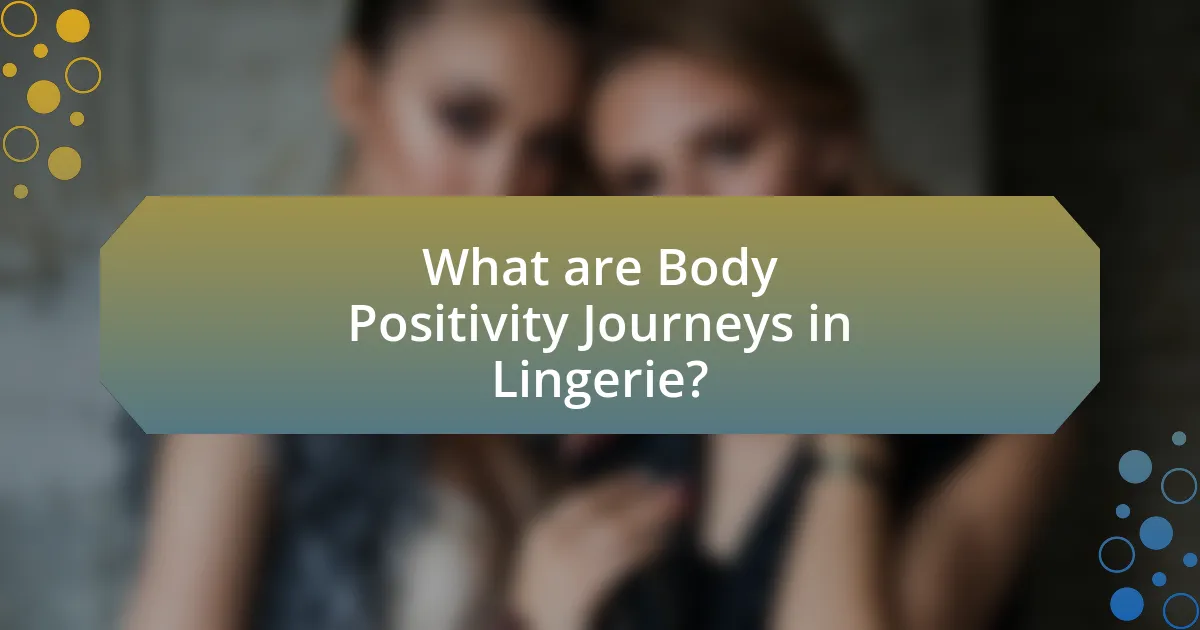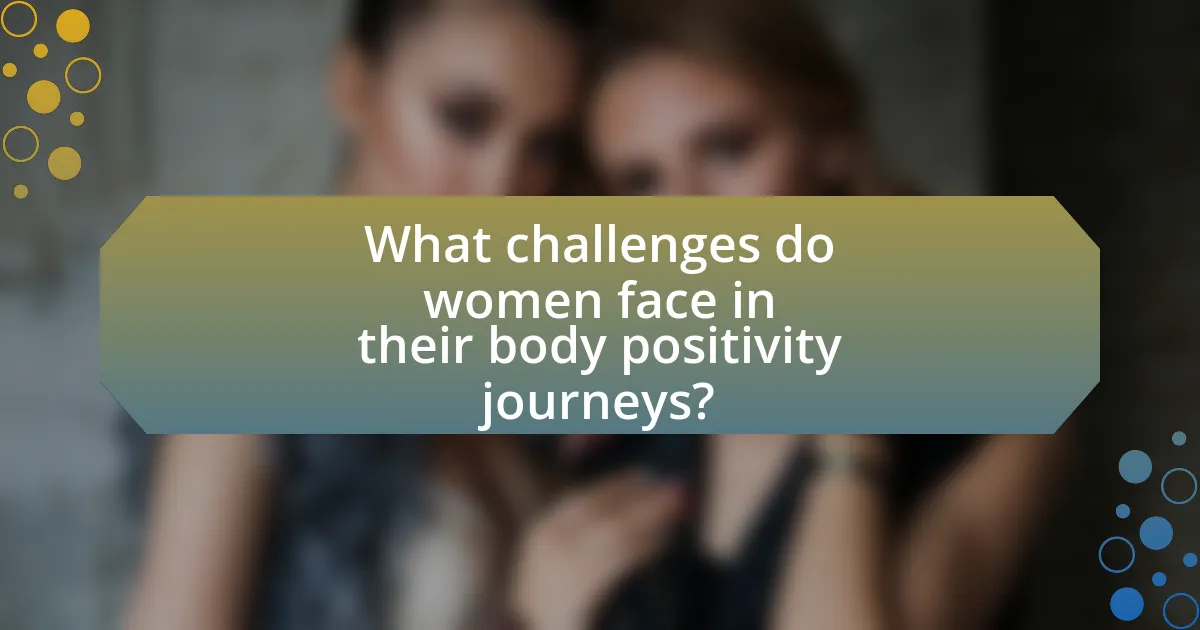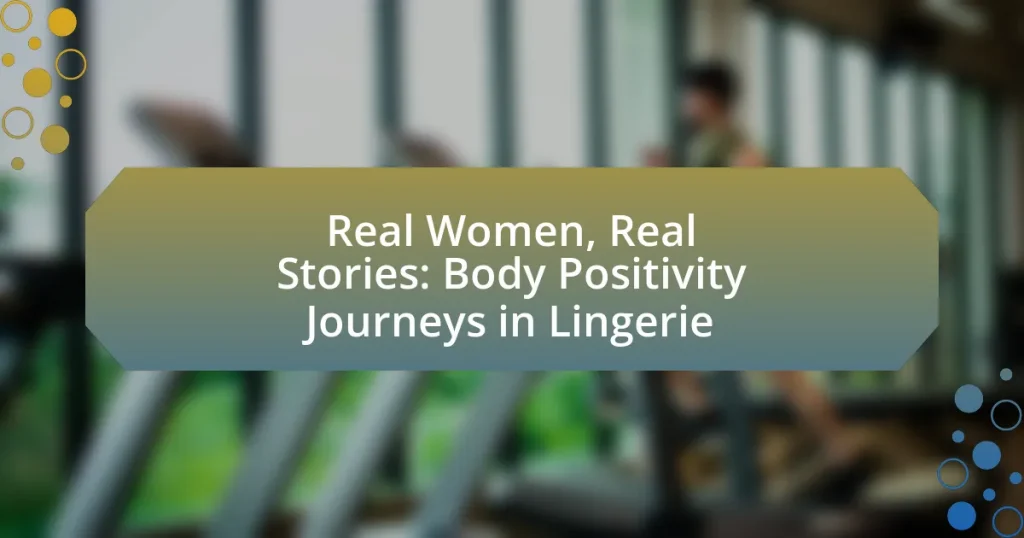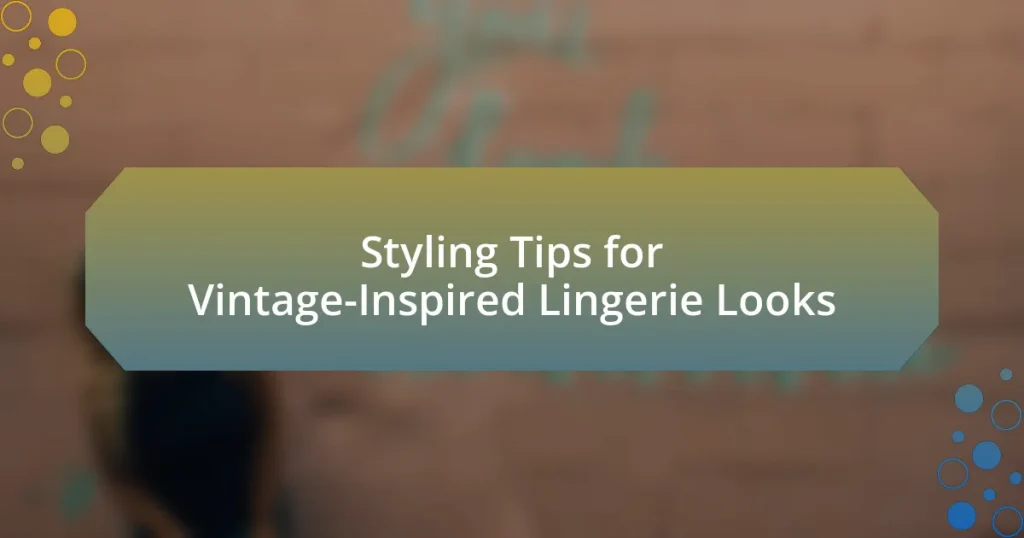The article “Real Women, Real Stories: Body Positivity Journeys in Lingerie” explores the transformative experiences of individuals as they embrace their bodies through lingerie, emphasizing self-acceptance and empowerment. It highlights how real women define body positivity, the personal experiences that shape their views, and the significant role lingerie plays in enhancing body confidence. The article also addresses the challenges women face due to societal standards, the importance of community support, and the impact of shared narratives on individual journeys. Additionally, it provides practical tips for women to enhance their body positivity through lingerie choices and discusses resources and organizations that support body positivity initiatives.

What are Body Positivity Journeys in Lingerie?
Body positivity journeys in lingerie refer to the personal experiences and transformations individuals undergo as they embrace their bodies while wearing lingerie. These journeys often involve overcoming societal beauty standards and self-acceptance, leading to increased confidence and empowerment. Research indicates that positive body image can significantly enhance mental well-being, with studies showing that individuals who engage in body positivity practices report higher self-esteem and lower levels of anxiety.
How do real women define body positivity in the context of lingerie?
Real women define body positivity in the context of lingerie as embracing and celebrating their unique bodies, regardless of societal standards. This perspective emphasizes self-acceptance and the belief that all body types deserve to be represented and feel beautiful in lingerie. Many women express that body positivity means choosing lingerie that makes them feel confident and comfortable, rather than conforming to traditional ideals of beauty. Research indicates that 67% of women feel more empowered when they wear lingerie that fits well and reflects their personal style, highlighting the importance of inclusivity in lingerie brands.
What personal experiences shape women’s views on body positivity?
Personal experiences that shape women’s views on body positivity include societal pressures, personal health journeys, and experiences with body image in relationships. Societal pressures often stem from media portrayals of ideal body types, which can lead to negative self-perception. Personal health journeys, such as overcoming eating disorders or chronic illnesses, can significantly alter a woman’s relationship with her body, fostering resilience and acceptance. Additionally, experiences in relationships, whether supportive or critical, can influence how women perceive their bodies, impacting their self-esteem and body image. These factors collectively contribute to a nuanced understanding of body positivity among women.
How does lingerie play a role in women’s body positivity journeys?
Lingerie plays a significant role in women’s body positivity journeys by promoting self-acceptance and confidence. When women wear lingerie that fits well and flatters their bodies, it can enhance their self-image and encourage them to embrace their unique shapes. Studies indicate that wearing well-fitting lingerie can lead to improved body satisfaction; for instance, a survey by the lingerie brand ThirdLove found that 70% of women reported feeling more confident when wearing a bra that fits properly. This connection between lingerie and body positivity is further supported by the growing movement towards inclusivity in lingerie sizing and styles, which empowers women of all shapes and sizes to feel beautiful and valued.
Why are real stories important in promoting body positivity?
Real stories are important in promoting body positivity because they provide authentic representation and relatability, which can challenge societal beauty standards. When individuals share their personal experiences, it fosters a sense of community and validation among those who may feel marginalized or insecure about their bodies. Research indicates that narratives from diverse body types can significantly enhance self-acceptance and reduce body dissatisfaction. For instance, a study published in the journal “Body Image” found that exposure to positive body stories can lead to improved body image and self-esteem among participants. This evidence underscores the impact of real stories in reshaping perceptions and encouraging acceptance of all body types.
How do personal narratives influence societal perceptions of body image?
Personal narratives significantly influence societal perceptions of body image by providing relatable experiences that challenge prevailing beauty standards. These narratives often highlight individual struggles and triumphs regarding body acceptance, fostering empathy and understanding among audiences. For instance, studies have shown that sharing personal stories about body image can lead to increased body positivity and reduced stigma, as evidenced by research published in the journal “Body Image,” which found that individuals who engage with diverse body narratives report improved self-esteem and body satisfaction. By amplifying voices that reflect a range of body types and experiences, personal narratives reshape societal norms and encourage a more inclusive understanding of beauty.
What impact do shared experiences have on individual journeys?
Shared experiences significantly enhance individual journeys by fostering a sense of belonging and validation. In the context of body positivity, when individuals share their stories, they create a supportive community that encourages self-acceptance and resilience. Research indicates that social support, derived from shared experiences, can lead to improved mental health outcomes, such as reduced anxiety and increased self-esteem. For instance, a study published in the Journal of Health Psychology found that individuals who engage in shared narratives about body image report greater satisfaction with their bodies and a stronger commitment to self-care practices. This collective sharing not only empowers individuals but also challenges societal norms, promoting a more inclusive understanding of beauty.

What challenges do women face in their body positivity journeys?
Women face numerous challenges in their body positivity journeys, including societal pressure, unrealistic beauty standards, and internalized negative self-image. Societal pressure often manifests through media portrayals that emphasize thinness and specific body types as ideals, leading to feelings of inadequacy among women who do not conform to these standards. Research indicates that exposure to idealized images can negatively impact women’s body satisfaction, as highlighted in a study published in the journal “Body Image” by Tiggemann and Slater, which found that media consumption correlates with body dissatisfaction. Additionally, women may struggle with internalized negative self-image, stemming from past experiences of criticism or bullying, which can hinder their ability to embrace body positivity. These challenges create a complex landscape for women seeking to cultivate a positive relationship with their bodies.
How do societal standards affect women’s self-image in lingerie?
Societal standards significantly impact women’s self-image in lingerie by promoting narrow definitions of beauty that often prioritize thinness and specific body types. These standards create pressure for women to conform to unrealistic ideals, leading to negative self-perception and body dissatisfaction. Research indicates that exposure to idealized images in media correlates with lower self-esteem among women, as they compare themselves unfavorably to these representations. A study published in the journal “Body Image” found that women who frequently engage with media portrayals of beauty report higher levels of body shame and lower body satisfaction. This demonstrates that societal expectations can distort women’s views of their bodies, particularly in intimate apparel contexts.
What are common misconceptions about body types and lingerie?
Common misconceptions about body types and lingerie include the belief that only certain body shapes can wear specific styles, and that lingerie is only for those with conventional beauty standards. Many people think that plus-size individuals should only wear full-coverage styles, while in reality, lingerie can be flattering and empowering for all body types, regardless of size or shape. Research from the Intimate Apparel Council indicates that 67% of women feel more confident when wearing lingerie that fits well, highlighting the importance of fit over body type. Additionally, the notion that lingerie is solely for the purpose of pleasing others overlooks its role in self-expression and personal comfort, which is essential for body positivity.
How do media representations influence women’s body positivity?
Media representations significantly influence women’s body positivity by shaping societal standards of beauty and self-acceptance. Positive portrayals of diverse body types in media can enhance women’s self-esteem and promote acceptance of their own bodies. For instance, research published in the journal “Body Image” by Tiggemann and Slater (2014) found that exposure to images of non-traditional body types led to increased body satisfaction among women. Conversely, negative representations can perpetuate unrealistic beauty standards, leading to body dissatisfaction and lower self-esteem. Thus, the media plays a crucial role in either fostering or undermining women’s body positivity through its representations.
What role does community support play in these journeys?
Community support plays a crucial role in body positivity journeys by providing emotional encouragement and fostering a sense of belonging among individuals. This support helps individuals feel validated in their experiences and promotes resilience against societal pressures regarding body image. Research indicates that social support networks can significantly enhance self-esteem and body image satisfaction, as seen in studies like “The Role of Social Support in Body Image and Eating Disorders” by T. M. McLaren and J. A. McKenzie, which highlights the positive impact of community on individual well-being.
How can women find supportive spaces for sharing their stories?
Women can find supportive spaces for sharing their stories by joining online communities, attending local support groups, or participating in workshops focused on body positivity. Online platforms like social media groups and forums dedicated to body positivity provide a safe environment for women to express their experiences and connect with others who share similar journeys. Local support groups often host events where women can share their stories in person, fostering a sense of community and understanding. Workshops focused on body positivity not only offer educational resources but also create opportunities for women to share their narratives in a supportive setting. These spaces are essential for promoting dialogue and empowerment among women.
What are the benefits of connecting with others on similar journeys?
Connecting with others on similar journeys fosters a sense of community and support, which is crucial for personal growth and emotional well-being. Engaging with individuals who share similar experiences can lead to increased motivation, as shared stories often inspire resilience and determination. Research indicates that social support significantly enhances mental health outcomes; for instance, a study published in the Journal of Health Psychology found that individuals with strong social networks report lower levels of anxiety and depression. Additionally, sharing experiences can provide valuable insights and practical advice, helping individuals navigate their own journeys more effectively.

What are the key elements of successful body positivity journeys in lingerie?
The key elements of successful body positivity journeys in lingerie include self-acceptance, representation, and community support. Self-acceptance allows individuals to embrace their bodies as they are, fostering a positive self-image. Representation in lingerie marketing, showcasing diverse body types, helps individuals see themselves reflected in the products, which can enhance feelings of validation and belonging. Community support, through social media or local groups, provides encouragement and shared experiences, reinforcing the message that all bodies are worthy of love and celebration. Studies indicate that positive body image is linked to improved mental health outcomes, highlighting the importance of these elements in fostering body positivity.
How can women embrace their bodies through lingerie choices?
Women can embrace their bodies through lingerie choices by selecting styles that enhance their natural shapes and reflect their personal preferences. Choosing lingerie that fits well and flatters individual body types can boost confidence and promote body positivity. For instance, studies show that wearing well-fitted lingerie can improve self-esteem, as it allows women to feel comfortable and attractive in their own skin. Additionally, opting for diverse styles, colors, and fabrics can help women express their unique identities, further reinforcing a positive body image.
What types of lingerie promote body confidence?
Lingerie types that promote body confidence include bralettes, high-waisted panties, and shapewear. Bralettes offer comfort and support without underwires, allowing for a more natural silhouette, which can enhance self-esteem. High-waisted panties provide coverage and accentuate curves, making wearers feel more secure and confident in their bodies. Shapewear, designed to smooth and shape the body, can boost confidence by creating a streamlined appearance under clothing. Studies show that wearing lingerie that fits well and aligns with personal style can significantly improve body image and self-perception, reinforcing the idea that comfort and style contribute to body confidence.
How can women select lingerie that aligns with their body positivity goals?
Women can select lingerie that aligns with their body positivity goals by choosing styles that enhance their comfort and confidence. Prioritizing fit is essential; well-fitting lingerie can significantly boost self-esteem, as studies show that 80% of women wear the wrong size, leading to discomfort and negative body image. Additionally, selecting fabrics that feel good against the skin, such as soft cotton or lace, can promote a positive experience. Women should also consider styles that reflect their personal taste, whether that be bold colors, playful patterns, or classic designs, as personal expression is a key component of body positivity. Finally, brands that promote inclusivity and diversity in their marketing can reinforce a positive self-image, as representation matters in fostering acceptance and love for one’s body.
What resources are available for women on their body positivity journeys?
Women on their body positivity journeys can access various resources, including online communities, social media platforms, workshops, and literature focused on self-acceptance. Online communities such as Body Positive and The Body Image Movement provide support and shared experiences, fostering a sense of belonging. Social media platforms like Instagram and TikTok feature influencers and advocates who promote body positivity, offering inspiration and relatable content. Workshops and seminars, often hosted by mental health professionals, provide tools for building self-esteem and challenging societal beauty standards. Additionally, books like “The Body Is Not an Apology” by Sonya Renee Taylor and “Body Positive Power” by Megan Jayne Crabbe offer insights and strategies for embracing body diversity and self-love. These resources collectively empower women to navigate their body positivity journeys effectively.
How can social media be a tool for empowerment in body positivity?
Social media can empower body positivity by providing a platform for diverse representations of bodies, allowing individuals to share their personal stories and experiences. This visibility challenges societal beauty standards and fosters a sense of community among those who may feel marginalized. Research indicates that exposure to body-positive content on platforms like Instagram can lead to improved body image and self-acceptance, as users engage with relatable narratives and supportive messages. For instance, a study published in the journal “Body Image” found that participants who followed body-positive accounts reported higher levels of body satisfaction and lower levels of body shame. Thus, social media serves as a crucial tool for promoting body positivity by amplifying voices that celebrate all body types and encouraging acceptance and love for oneself.
What organizations support body positivity initiatives in lingerie?
Organizations that support body positivity initiatives in lingerie include Aerie, which promotes body diversity through its #AerieREAL campaign, and Savage X Fenty, known for its inclusive sizing and diverse representation in marketing. Additionally, the National Eating Disorders Association (NEDA) advocates for body positivity and self-acceptance, influencing the lingerie industry by promoting healthy body image. These organizations actively challenge traditional beauty standards and encourage acceptance of all body types, contributing to a more inclusive lingerie market.
What practical tips can women apply to enhance their body positivity journeys?
Women can enhance their body positivity journeys by practicing self-affirmation, engaging in positive self-talk, and surrounding themselves with supportive communities. Self-affirmation involves regularly acknowledging and appreciating one’s unique qualities, which has been shown to improve self-esteem and body image. Positive self-talk, which includes replacing negative thoughts with constructive ones, can significantly shift perceptions of body image. Research indicates that social support plays a crucial role in body positivity; being part of a community that promotes acceptance and diversity can reinforce positive feelings about one’s body.














